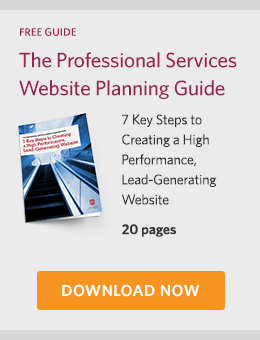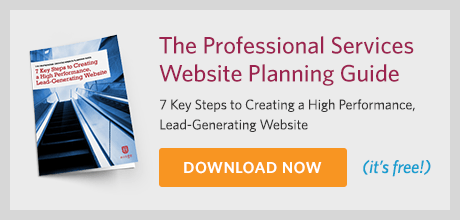What separates a professional services website that builds your business from one that simply describes it?
The first type plays an active role in business development, attracting a steady stream of quality leads, nurturing them over time and contributing materially to your firm’s growth.
The second type does none of the above – yet is far more common. These websites are largely passive. They are a place to send prospects whom you meet in person to learn more about your firm and its services.
While there is nothing inherently wrong with these traditional, brochure-style websites, they aren’t built to address a large and growing segment of the market: modern buyers of professional services who find and vet potential service providers online.
So what sets a business-building website (we call these “high-performance” sites) from a descriptive website? I would argue that there are 5 characteristics — all website best practices — of a high-performance website:
- Built around educational content
- A strong focus on SEO
- Displays offers throughout the site
- Employs forms extensively
- Uses analytics and A/B testing to understand and improve performance
Let’s look at each of these best practices in turn.
Best Practice 1: Produce Valuable Educational Content
The modern professional services website requires that you think about marketing differently. It represents a shift from talking about your expertise to demonstrating it. And how do you demonstrate your expertise?
- You write and speak openly about how your clients can solve common problems.
- You describe specific techniques and provide critical context.
- You use language that is relatively simple and easy to understand.
In short, you make complicated topics seem simple. This ability to simplify the complicated is a hallmark of a true expert, and many of your prospective buyers crave this kind of information. Their businesses have real challenges, and individuals in those firms are tasked with solving them. But before they hire a service provider, they need to understand their problem and what options are available to fix them.
To feed this need, your website should be both a receptacle and promotional vehicle for your expert content. In fact, this content can dramatically expand your firm’s reach, drawing in interested, motivated visitors from around the nation and the globe.
At professional services firms that embrace content marketing, it’s not uncommon for the vast majority – we’re talking over 90% — of visitors to enter their website through a piece of educational content. Many of these become repeat visitors — and, over time, devoted followers.
When they are ready to buy services, these devotees will think first of the firm’s they’ve come to trust online.
To learn more about content marketing and how to apply this website best practice to your site, check out the free Content Marketing Guide for Professional Services Firms.
Free Download: Website Planning Guide
Best Practice 2: Take Search Engine Optimization (SEO) Seriously
Firms that invest heavily in content marketing — and most high-growth firms do — understand that SEO is a key factor in their success.
Think of SEO as a powerful magnet capable of attracting thousands of new visitors to your website each month.
Now, SEO is not a single technique that you apply to your web pages, then sit back. Instead, it is a suite of techniques that involve a variety of skills — some technical and some softer, such as reaching out and negotiating with third-party online publications.
At its most fundamental level, search engine optimization comprises two components:
- On-site optimization
- Off-site optimization
Onsite optimization is focused on building a website that can deliver high-ranking pages. It requires a wide range of skills, such as researching keyword phrases, writing, and building your pages to meet the increasingly high standards of Google’s search algorithm, among many others.
Offsite optimization is all about developing high-quality links to your website and select individual pages. This can be accomplished by creating high-value content to which other websites like to link, as well as writing guest articles and blog posts on reputable third-party sites and including links back to your site. Google sees high-quality links back to your site as “votes” for your content. These backlink endorsements are usually the most powerful driver of high rankings in search engines.
You can learn more in our SEO Guide for Professional Services, 2nd Edition.
Free Download: Website Planning Guide
Best Practice 3: Employ Offers Throughout Your Site
Attracting visitors to your website is not enough. You need a mechanism to turn casual visitors into raving fans. And that transformation can only happen if you have produced content for people at multiple stages of your sales funnel.
Suppose someone first discovers you through a blog post. You need a way to keep them engaged and demonstrate that you have a deep understanding of the topic. A proven way to do this is to produce a number of longer, more in-depth pieces of content (such as executive guides, ebooks and webinar recordings) on topics that span your range of expertise.
Then you need a way to introduce the long-format content to your new visitors. You do this with offers — mini on-page advertisements that point readers to highly relevant, next-stage material.
 Consider placing offers on many, if not most of your pages — especially the most trafficked ones, including your homepage. But not all offers should promote content. To cater to people at the bottom of your funnel, those who are almost ready to buy, you will need offers that drive them to a relevant service or deliver a more personal experience, such as a free consultation.
Consider placing offers on many, if not most of your pages — especially the most trafficked ones, including your homepage. But not all offers should promote content. To cater to people at the bottom of your funnel, those who are almost ready to buy, you will need offers that drive them to a relevant service or deliver a more personal experience, such as a free consultation.
Look at the page you are reading now. How many offers do you see. And what do they promote?
Best Practice 4: Place Your Most Valuable Content Behind Forms
Forms are the way you turn visitors into prospects. So put your most valuable, enticing stuff behind them. Gated content works because most people are willing to exchange a small amount of personal information for something they perceive as valuable.
You can use that personal information, especially their email address, to build a marketing relationship. This relationship involves sending the person additional educational material over time, not spamming them with sales pitches.
Of course, a form is a barrier, too. Any time you use one, you will turn off a certain proportion of people who might enjoy that content. But it’s a tradeoff worth making. People who fill out forms tend to be more serious about the topic, and they are more likely to become clients eventually. And it is a truth universally acknowledged that the more fields you put on a form, the fewer people will fill it out. So one of your jobs will be to determine how much information to collect — and where you strike that balance between losing potential prospects and letting in the most qualified ones.
The bottom line? If you produce great content but don’t gate any of it, you are missing the entire point of content marketing.
Best Practice 5: Use Analytics and Testing to Monitor and Improve Your Performance
According to our latest research, the best performing firms monitor 22% more metrics than their low-growth peers. They are also far more likely to keep an eye on online performance metrics like conversions and social media engagement.
The reason? You can’t steer a boat if you can’t see where you are going. Analytics shine a strong light into the darkness. And they give you the ability to change course if you don’t like what you see. There are many analytics tools out there — enough to make your head swim. So start with the basics.
Google Analytics is a free package with more than enough power for most firms out there. You will be hard pressed to use all of its features.
You can track likes and shares in the Twitter, Facebook, LinkedIn and YouTube apps. Or you can try a third-party social analytics tool like Hootsuite or Kissmetrics.
Savvy firms are also aware that they don’t always know what works. To find out, they conduct scientific tests, called A/B tests, to discover whether small tweaks to a web page — changing a headline or the color of a button — will affect performance. Tools like Optimizely make this process relatively simple, even for non-technical marketers.
So why haven’t more firms embraced these website best practices? In most cases, it’s because building a high-performance website requires retooling their entire approach to marketing. And that’s very hard and painful. But in the professional services marketplace, change is constant. And firms have to adapt, even when the going gets tough.
I hope that these five best practices inspire your firm to reevaluate your approach to marketing — and the role your website plays in selling your services.
I guarantee you won’t regret it!
Additional Resources:
- Our Lead Generating Website Guide details how your firm can generate qualified leads with its website.
- And our free Lead Nurturing Guide will show you how to nurture those leads through the sales cycle.
- Hinge University offers a wealth of tools and information to make your website more powerful and persuasive.
How Hinge Can Help:
Your website should be one of your firm’s greatest assets. Our High Performance Website Program helps firms drive online engagement and leads through valuable content. Hinge can create the right website strategy and design to take your firm to the next level.


